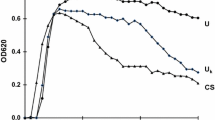Summary
Chemical findings were obtained from 24 h urine samples of 43 male calcium-oxalate stone-formers on an unrestricted diet. Results were compared with data from 51 age-matched healthy blood donors. No differences were found in the excreted quantities of calcium, oxalic acid, uric acid and inorganic phosphate, nor in the calcium to creatinine ratio or the activity product of calcium and oxalic acid. The only differences were a higher output of magnesium and a higher magnesium to calcium ratio for controls. The extent of these differences, however, does not justify further subdivision of the group of stone-formers. The diagnostic and therapeutic significance of the chemical analysis of one 24 h urine sample is doubtful for this group of patients.
Similar content being viewed by others
Abbreviations
- ASF:
-
aktive Kalziumoxalatsteinformer
- CV:
-
Variationskoeffizient
- G:
-
Gesunde
Literatur
Albright F, Henneman P, Bendict PH, Forbes AP (1953) Idiopathic hypercalciuria. Proc R Soc Med 46:1077–1081
Battaille P, Charransol G, Grégoire I, Daigre JL, Coevoet B, Makdassi R, Pruna A, Lacquet P, Sueur JP, Fournier A (1983) Effect of calcium restriction on renal excretion of oxalate and the probability of stones in the various pathophysiological groups with calcium stones. J Urol 130:218–223
Bisaz S, Felix R, Neuman WF, Fleisch H (1978) Quantitative determination of inhibitors of calcium phosphate precipitation in whole urine. Min Electrol Metabol 1:74–83
Boyce WH, Garvey FK, Goven CE (1958) Abnormalities of calcium metabolism in patients with “idiopathic” urinary calculi. JAMA 166:1577–1583
Broadus AE, Dominguez M, Bartter FC (1978) Pathophysiological studies in idiopathic hypercalciuria: Use of an oral calcium tolerance test to characterize distinctive hypercalciuric subgroups. J Clin Endocrinol Metabol 47:751–760
Bulusu L, Hodgkinson A, Nordin BEC, Peacock M (1970) Urinary excretion of calcium and creatinine in relation to age and body weight in normal subjects and patients with renal calculus. Clin Sci 38:601–612
Cottet J, Vittu C (1955) Calcium urinaire et lithiases urinaires. Pr méd 63:878–879
Desmars JF, Tawashi R (1973) Dissolution and growth of calcium oxalate monohydrate. Biochim Biophys Acta 313:256–267
De Wardener HE (1985) The kidney. An outline of normal and abnormal function (Fifth edition), Churchill Livingstone, Edinburgh, p 357
Elliot JS (1968) Calcium stones: the difference between oxalate and phosphate types. J Urol 100:687–693
Elliot JS (1983) Calcium oxalate uriniary calculi: clinical and chemical aspects. Medicine 62:36–43
Flocks RH (1940) Prophylaxis and medical management of calcium urolithiasis: The role of the quantity and precipitability of the urinary calcium. J Urol 44:183–190
Hodgkinson A, Pyrah LN (1958) The urinary excretion of calcium and inorganic phosphate in 344 patients with calcium stone of renal origin. Br J Surg 46:10–18
Hodgkinson A, Williams A (1972) An improved colorimetric procedure for urine oxalate. Clin Chim Acta 36:127–132
Hodgkinson A (1974) Relations between oxalic acid, calcium, magnesium and creatinine excretion in normal men and male patients with calcium oxalate kidney stones. Clin Sci Mol Med 46:357–367
Hodgkinson A (1977) Oxalic acid in biology and medicine. Academic Press, London New York San Francisco, pp 164–170
Hoffman WS (1970) The biochemistry of clinical medicine. Year Book Medical Publishers, Chicago, pp 326–327
Johansson G (1979) Magnesium metabolism. Studies in health, primary hyperparathyroidism and renal stone disease. Scand J Urol Nephrol Suppl 51:13
Johansson G, Backman U, Danielson BG, Ljunghall S, Wikström B (1980) Magnesium metabolism in renal stone disease. Inv Urol 18:93–96
Knapp EL (1947) Factors influencing the urinary excretion of calcium. J Clin Invest 26:182–202
Lemann J Jr, Adams ND, Gray RW (1979) Urinary calcium excretion in human beings. New Engl J Med 30:535–541
Ljunghall S, Waern AU (1977) Urinary electrolytes in renal stone formers and healthy subjects. Scand J Urol Nephrol Suppl 41:55–75
Marshall RW, Robertson WG (1976) Nomograms for the estimation of the saturation of urine with calcium oxalate, calcium phosphate, magnesium ammonium phosphate, uric acid, sodium acid urate, ammonium acid urate and cystine. Clin Chim Acta 72:253–260
Nordin BEC, Hodgkinson A, Peacock M (1967) The measurement and the meaning of urinary calcium. Clin Orthop 52:293–322
Oreopoulos DG, Soyannwo MAO, Mc Geown MG (1968) Magnesium/calcium ratio in urine of patients with renal stones. Lancet 2:420–422
Pak CYC, Fetner C, Twonsend J, Brinkley L, Northcutt C, Barilla DE, Kadesky M, Peters P (1978) Evaluation of calcium urolithiasis in ambulatory patients. Am J Med 64:979–987
Robertson WG, Morgan DB (1972) The distribution of urinary calcium excretion in normal persons and stoneformers. Clin Chim Acta 37:503–508
Stransky M (1985) Persönliche Mitteilung (Publikation in Vorbereitung)
Tiselius HG, Almgard LE, Larsson L, Sörbo B (1978) A biochemical basis for grouping of patients with urolithiasis. Eur Urol 4:241–249
Tschöpe W, Ritz E (1985) Diagnostik der Nephrolithiasis. Dtsch med Wochenschr 110:381–385
Wissenschaftliche Tabellen Geigy (1980) Teilband Statistik, 8. Auflage, Basel pp 63, 156–162, 230
Author information
Authors and Affiliations
Rights and permissions
About this article
Cite this article
Riess, C., Hess, B. & Binswanger, U. Fragliche Aussagekraft der chemischen Analyse eines einzelnen 24 h-Urins bei rezidivierender Kalziumoxalat-Nephrolithiasis. Klin Wochenschr 64, 411–416 (1986). https://doi.org/10.1007/BF01727526
Received:
Revised:
Accepted:
Issue Date:
DOI: https://doi.org/10.1007/BF01727526




